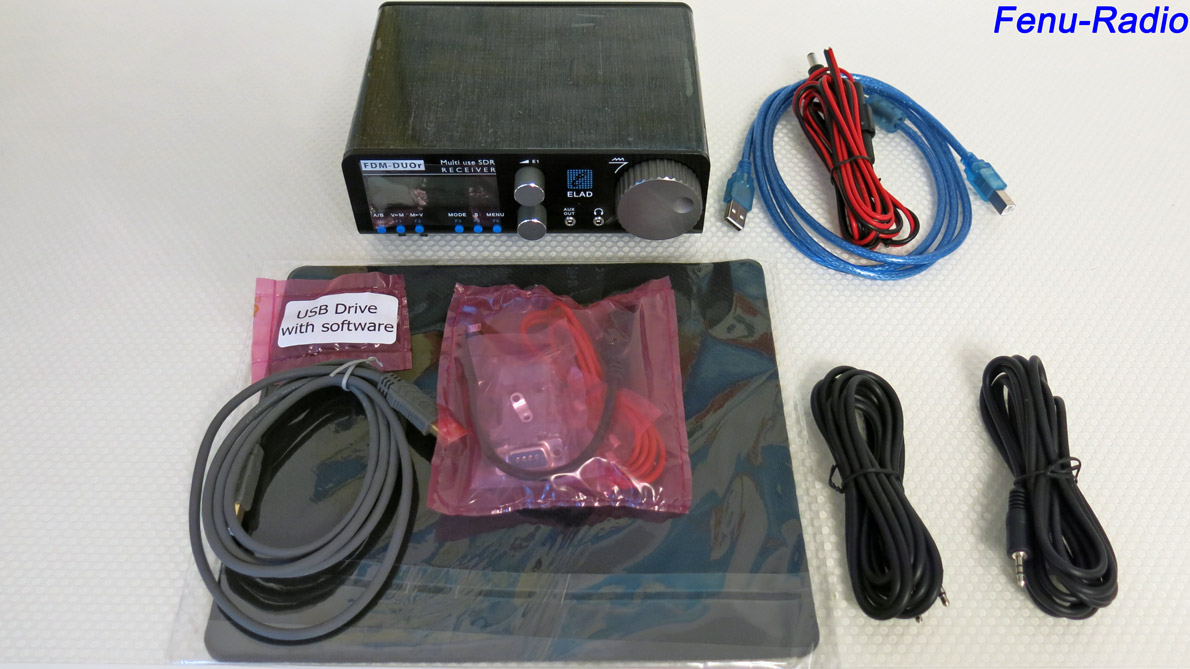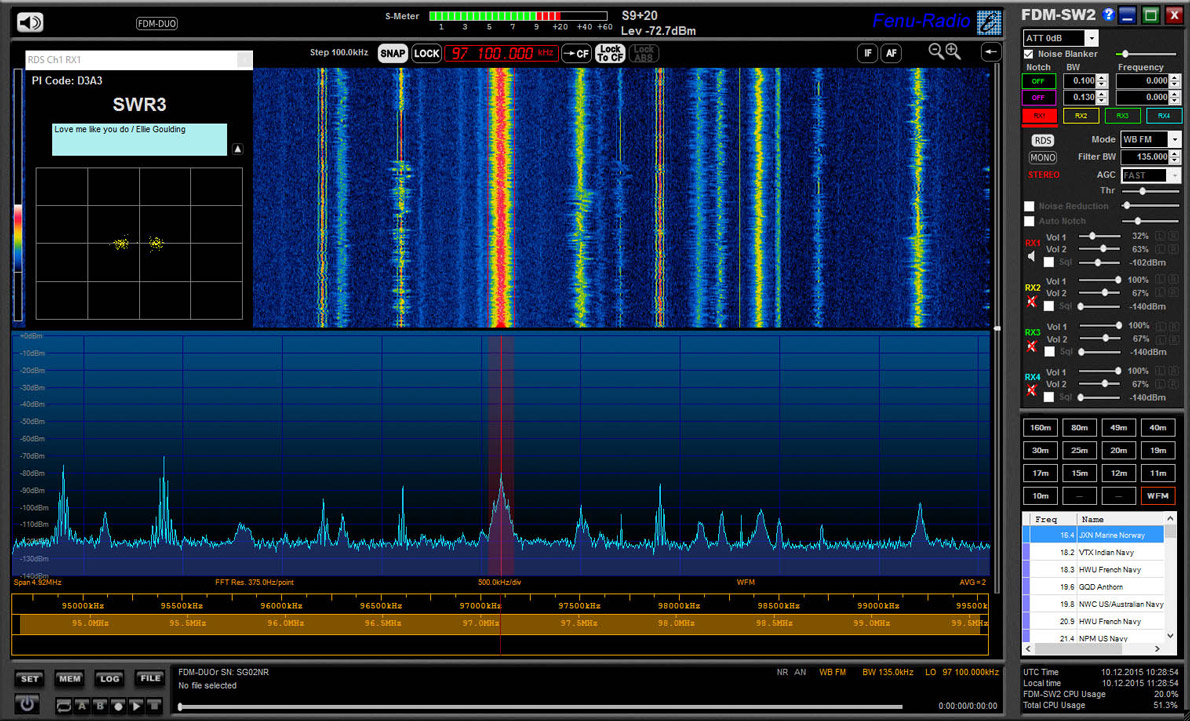|
For over a year after it had been announced in the summer of 2014, the ELAD FDM-DUOr is finally available. After solving some technical difficulties, ELAD succeeded to offer for the first time a flexible and powerful SDR receiver. As a table top receiver it has the most important functions, which are PC-controlled, e.g., spectrum display and many other features. This is what many SWL have been waiting for. In the beginning of October, on a Tuesday, a DHL courier rang the doorbell and delivered a small parcel coming from Italy. It was hard to believe, but the FDM-DUOr had arrived. On the previous Saturday I had received notification from Franco Milan that my FDM-DUOr was ready for delivery and would be shipped on Monday. It took less than 24 hours for the parcel to arrive from Italy. It couldn't have been any faster. The FDM-DUOr comes in an inconspicuous box and is well packed. Additionally, the case and the display of the radio are protected by protective foil. There are lots of extras that come with the FDM-DUOr:

The constructional quality of the radio is very good. The case is made completely of black anodized aluminum. The large VFO is also made of aluminum and easy to handle. The two small controls are made of plastic but they have an aluminum-like coating. Because of its foldable stand, you can tilt the radio into a comfortable operating position. The most important features:
Block diagram of the FDM-DUOr
With permission from ELAD Front-End (Preselection) of the FDM-DUOr With the configurable preselector of the DUOr, ELAD breaks new ground in building SDRs. The preselector has 10 slots. Each slot can be configured individually with band pass filters and/or high pass/low pass filters. ELAD offers plug-in boards for all ham radio bands. Unfortunately though, the needs of radio listeners have not been considered so far. When the DUOr was launched, there were no band passes for the broadcasting bands available. My receiver, which was one of the first ones, had three band passed built in, one of them in the beta version. The other two came with the radio. My DUOr had the following plug-ins:
The preselector is configured with the FDM-DUO Manager, which is integrated in the software SW2. Antenna 1: 9kHz-54MHz (is passed through a low pass filter which suppresses signals above 54 MHz) Antenna 2: 54MHz - 108 MHz (dependent on the built in band pass filters) Operation of the FDM DUOr Finally, the small FDM-DUOr is on my table. ELAD was right to include a small anti-slip mat because the radio slides on a smooth surface, especially when you press one of the three encoders. OK, let's go! On the front panel, you are looking in vain for an "ON" switch. Just in the case of the FDM-S2, this knob is on the rear panel. If you have the FDM-DUOr permanently installed in your shack, switching the radio on is quite inconvenient. You have to slide it forward to reach the sliding switch. If you succeeded, the blue-lit display will appear. All symbols become visible for one second, which could be a self-test. The buttons E1 and E2 are encoders which also have a push button function. With the Encoder 1 (E1) the following functions appear in this order: Volume, Squelch, AGC On/Off, AGC Slow, Medium, Fast or Gain with AGC off, NR, NB, AutoNotch
The Encoder 2(E2) controls the following functions: Band filter widths, CW pitch, RIT On/Off, RIT value RIT means: Receiver Incremental Tuning. You can use this in case two SSB stations have a slight frequency offset.
The large VFO is non-locking and also has a push-button function. By pressing the VFO, you will get into the step menu. A short push activates the "Quickstep" menu. The following step widths are available: 1Hz, 5Hz, 25Hz, 50Hz, 100Hz, 250Hz, 500Hz, 1kHz, 2kHz, 3kHz, 4.5kHz, 5kHz, 7.5kHz, 9kHz, 10kHz, 12.5KHz, 25kHz, 50kHz, 100kHz, 125kHz, 250kHz, 500kHz, 1MHz. If you push the button more than one second, you activate the "Digit by Digit" menu. Thus you can point to any digit in the frequency display and can select 10Mhz steps, e.g. The DUOr in Action (HD Video) The small blue Buttons have following functions:
After some getting used to, working with the DUOr is relatively easy. After selecting the mode, band width, tuning steps, AGC threshold etc., you can finally start. Or rather almost! Although the DUOr has a loudspeaker built in, you shouldn't expect a sound sensation. This mini-loudspeaker is more meant to be for audio-control and not for listening. A good active loudspeaker or good headphones are required. Reception as a table top For two months, I tested the DUOr intensively and compared it to the Icom-R9500, Lowe HF-225 Europa, Perseus SDR and the RFSpace Cloud-IQ. For antennas I used my Fenu-CrossLoop/RLA4B (1.2mē) and the ML200 with almost 4mē. Both antennas render high levels with best signal/noise ratio. The first thing you'll notice is the quiet reception. The noise floor is very pleasant. Due to the AGC-threshold, you can reduce the noise to a minimum. But you have to make sure not to select too high a threshold, otherwise the receiver will become insensitive. The default value is 4, which is a good compromise. The AGC-threshold is adjustable in 10 steps, which proved to be too coarse. The possibility of smaller steps would have been desirable. On VLF, LW and MW, the DUOr beat the IC-R9500, which is a little insensitive in this frequency range. On the other hand, the Lowe HF-225 Europa could keep up in these bands. Both receivers had about the same sensitivity. But as far as strong signal immunity is concerned, the result was different. Here the IC-R9500 was the leader. The DUOr took turns with the HF-225. With the HF-225 Europa you could hear "ghost stations" above MW. On the other hand, the ADC-Clipping light "PK" lit up, which points to an overmodulation of the ADCs. But there were no "ghost stations". The audio of the DUOr is treble prone, which is good for intelligibility. The music playback is a little tinny. In this respect, the analogue receivers are preferable. On shortwave, the IC-R9500 was clearly the winner. No wonder! This luxury receiver has every tool necessary for improving reception. But the DUOr was not bad, either. It could receive weak signals just as good as the other two radios. It should be mentioned that the DUOr does not lose sensitivity in the higher frequency bands. In the 10m band, you had to make use of the IC-R9500's preselector to compensate for the loss of sensitivity. With the HF-225 Europa, very weak signals were buried under the noise. Because of the individually configurable preselector, the DUOr showed no large signal problems but only as far as the filtered band passes are concerned. Outside these band passes, the ADC overmodulated and the "PK" indicator lit up very often but "ghost stations" were never noticed, which points to the fact that the DUOr has the same electronics for reception as the FDM-S2. Both receivers reacted in the same manner. The noise blanker, which can be adjusted in 10 steps, worked very well and effectively suppressed the interferences coming from a nearby pasture fence. In some cases, the noise reduction (NR), which can also be adjusted in ten steps, was helpful. For both these features, a better fine adjustment would have been desirable. SDR Reception via PC I used the supplied ELAD SW2 software in the version 1_107beta for the tests of the radio as an SDR controlled by a PC. In the meantime, this software offers almost everything, which the SWL or ham radio operator desires. The DUOr can be configurated with the FDM-DUOr manager, which is integrated in the SW2 software. The following parameters can selected:
I compared the DUOr to the Perseus SDR and the RFSpace Cloud-IQ. For all three receivers, I used the manufacturers' software. Concerning sensitivity the following can be said: The DUOr is on the same level as the Perseus, except for the higher frequencies, where the Perseus is not just as good. Over the complete frequency range, the Cloud-IQ is a little bit more sensitive than the other two receivers. All other factors, except for the preselection, are determined by the software. In this respect, the SW2 is practically flawless and offers the most functions. Only the slow spectrum of the SW2 spoils this overall impression. If you tune the radio with the mouse wheel, the spectrum follows with rather long a delay. This also happened with the FDM-S2. Other than that, the combination of the DUOr and the SW2 works flawlessly. As already mentioned, the SW 2 offers a high standard and makes full use of the DUOR's overall qualities. DRM can be decoded without additional software. What is really nice is the possibility of combining both modes : table top receiver and PC-operation. The table top can be tuned and listened to and at the same time you can watch the spectrum on the PC. To make use of this feature, you have to deactivate the SW2's"Snap" function. Reception of FM is also possible, but it only works with the appropriate band pass filter. For testing purposes, my receiver came with the FM- band pass filter in the beta version. Generally, the DUOr can only be tuned up to 54 MHz. If you own the FM band pass filter, the radio has to be activated for FM operation. This is done in a system file of the SW2 software. If you start the software again with the radio switched on, the modified system file will activate the upper frequency range of the FM band. FM reception is only possible in the PC mode. Of course, the SW2 offers stereo reception of the FM bands. There is also a fast RDS indicator which shows all relevant RDS data. For FM -Dxing, the combination of the DUOr and SW2 works very well. Conclusion: The ELAD FDM-DUOr is a welcome addition to the receiver market. At the time of testing, it is the only SDR reviver which combines the two features: table top receiver and PC-operation. Both alternatives can be used at the same time. This is completely innovative! Because of its individually configurable preselector, the DUOr can be tailored to the listeners' needs. Unfortunately though, some things are not quite fully developed. The software, which controls the DUOr in the table top mode, needs some fine tuning. There is the AGC threshold, whose steps are too coarse and also adjusting the noise reduction and noise blanker should be more exact. But ELAD tries constantly to improve the software. Therefore, it can be assumed that the small flaws will be corrected and new functions will even be added. The lack of band pass filters for "General Coverage" must be criticized as well. As of December 2015, the available band pass filters are only customized for the amateur radio bands. The radio is an outstanding product. Top class! posted 10.12.2015
|


.jpg)







